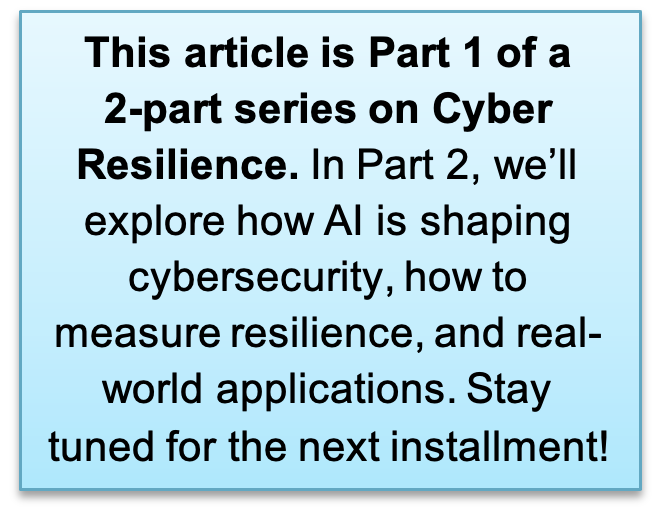(Part 1 of 2 in the Cyber Resilience Series)
Insights From the Desk of our Director of Cybersecurity, Chris LeGrand – February 2025
 Even the top industry juggernauts can fall. In 2023, after 150 years in business, the prominent logistics company KNP shook the news headlines when it was the victim of a devastating ransomware attack.
Even the top industry juggernauts can fall. In 2023, after 150 years in business, the prominent logistics company KNP shook the news headlines when it was the victim of a devastating ransomware attack.
Orchestrated by the Russian-based Akira group, attackers exploited a weak employee password to infiltrate KNP’s systems — demanding millions in cryptocurrency and holding captive (and threatening to release) countless sensitive company records.
Despite having cybersecurity insurance and accreditation, KNP’s lack of a robust cyber resilience strategy ultimately led to its closure within three months. Nearly 730 jobs were lost (“My Company Thrived for 150 Years”1), and a company that lasted decades became a distant memory.
This harrowing example underscores the consequences of inadequate preparation and sets the stage for a deeper understanding (and significance) of cyber resilience.
Understanding Cyber Resilience
 Cyber resilience is how well you prepare for, respond to, and recover from cyber incidents.
Cyber resilience is how well you prepare for, respond to, and recover from cyber incidents.
The idea acknowledges that data breaches are, in many cases, inevitable. And unlike traditional cybersecurity, which focuses on preventing attacks, cyber resilience emphasizes adaptability and business continuity.
By leaning into this expanded scope, you can shift from purely defensive postures to a more balanced strategy that keeps your business operational despite growing cyber risks.
Why Cyber Resilience Matters
Cyber threats aren’t as simple as a malicious email convincing someone to take an action. They’ve evolved and present new challenges to organizations via more sophisticated and targeted attacks.
As a result, regulatory frameworks (e.g., General Data Protection Regulation (GDPR)) have stepped in. They mandate robust data protection and incident response mechanisms so companies can stay compliant and safeguard sensitive proprietary and customer information.
Aside from the risk and compliance implications, recovering quickly from cyber incidents is an easy way to maintain customer trust and mitigate reputational damage from a breach. Operational continuity (and subsequent revenue) is also at stake. Downtime from cyber attacks can cost organizations millions. And implementing resilience-focused strategies minimizes such disruptions and financial losses.
These pillars demonstrate what’s truly at stake and that cyber resilience extends beyond IT departments — influencing business longevity, customer loyalty, and regulatory compliance.
Core Pillars of Cyber Resilience
1. Risk Assessment and Management
Regular risk assessments across your enterprise and IT infrastructure let you see where you’re most vulnerable. And by analyzing potential attack vectors specific (and common) to your industry, you can prioritize these risks and allocate resources to address high-impact vulnerabilities first.
2. Proactive Cybersecurity Measures
Proactive measures like employee training, advanced threat detection systems, and adopting a Zero Trust Architecture (ZTA) can put you on a path to cyber resilience. Additionally, educating your staff to recognize and report phishing (plus other threats) is the best way to mitigate a leading cause of security breaches: human errors.
3. Incident Response Planning
A well-crafted, documented, and practiced incident response plan keeps cyber attacks from unfolding into something catastrophic. When you regularly conduct drills to test and refine your response plan, you ensure all stakeholders know their roles and responsibilities if and when an actual cyber incident occurs.
4. Robust Backup and Recovery Systems
Regular backups of critical data and comprehensive disaster recovery plans keep cyber attacks from affecting your operations and overall bottom line. By having restored systems and data constantly ready for deployment, you can minimize downtime, disruptions, and lost revenue.
5. Collaboration and Information Sharing
It’s us vs. threat actors. Engaging in industry collaboration and threat-intelligence sharing with peers and government agencies helps everyone stay ahead of emerging threats and achieve cyber resilience.
Bottom Line: The Best Cyber Defense is Preparation
Cyber threats don’t wait, and neither should your organization. Being resilient is no longer optional—it’s mission-critical. By implementing proactive cybersecurity strategies today, you can protect your operations, maintain customer trust, and stay ahead of the evolving threat landscape. In Part 2, we explore how AI is revolutionizing cyber resilience and how businesses are successfully defending themselves in the real world. Stay ahead of the curve—don’t miss it.
______________________
1 Abbott, Paul. “My Company Thrived for 150 Years—Then Russian Hackers Brought It Down in Three Months.” The Times, 13 Dec. 2024, https://www.thetimes.co.uk/article/hackers-destroyed-my-company-by-guessing-an-employees-password-62vcbddpx.

















